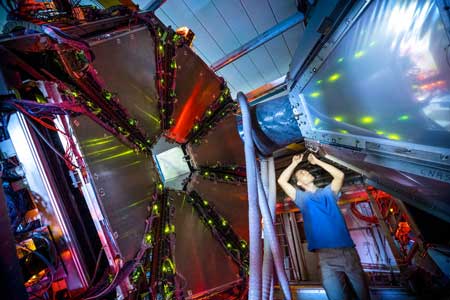| Aug 09, 2019 |
800 billion degrees Celsius: temperatures as they occur in star collisions measured in the laboratory
|
|
(Nanowerk News) They are among the hottest moments in cosmic events: the collisions of neutron stars in the universe, in which chemical elements are formed. With particle collisions in the accelerator scientists are able to create similar conditions at the GSI Helmholtzzentrum für Schwerionenforschung and the future FAIR accelerator center.
|
|
Now, an international group of researchers at the HADES collaboration has succeeded for the first time in measuring the thermal electromagnetic radiation – the so-called black-body radiation – produced in this process.
|
|
The results were recently published in the journal Nature Physics ("Probing dense baryon-rich matter with virtual photons, The HADES Collaboration").
|
|
The HADES detector system on the GSI and FAIR campus in Darmstadt, as tall as a house, provides researchers with exciting insights into the events of the collision of two heavy nuclei at relativistic energies and – as has now been very successfully done – allows them to track down the microscopic properties of extreme states of matter in the laboratory.
|
 |
| The detector HADES from the inside. (Image: J. Hosan/GSI Helmholtzzentrum für Schwerionenforschung GmbH)
|
|
The latest results of the HADES collaboration, involving more than 110 scientists from numerous countries, mark an important moment: “The reconstruction of thermal radiation from compressed matter is a milestone in the understanding of cosmics forms of matter. It not only allows to extract the temperature of the system formed in the collision but also provides deep insight into the microscopic structure of matter under such conditions,” says Professor Joachim Stroth, spokesperson of the HADES collaboration, who coordinated the current analyses together with Professor Tetyana Galatyuk. Numerous other scientists from GSI and FAIR were involved in the current publication.
|
|
The Scientific Managing Director of GSI and FAIR, Professor Paolo Giubellino, whose research focus is the physics of high-energy heavy ion collisions and the matter produced in them, is already looking forward to the future and to the worldwide unique accelerator center FAIR, which is currently being built at GSI: “HADES will continue to contribute a lot to the exploration of atomic nuclei and their building blocks and will be an important part of FAIR's Compressed Baryonic Matter (CBM) experiment. Among other things, researchers there will be able to investigate processes within neutron stars with unprecedented precision and over a very wide range of densities."
|
|
The electromagnetic radiation observed by the HADES detector within the scope of the study now presented is mediated by virtual photons. They exist for an instant and soon decay into a pair of leptons (dilepton), e.g. an electron and a positron. Since leptons do not undergo strong interactions, the dense hadronic medium is nearly transparent to this radiation.
|
|
Nevertheless, it is produced throughout the whole evolution of the reaction and therefore provides an ideal probe for the microscopic properties of the dense and hot medium created in the collision. From the spectral distribution of the radiation it could be deduced, that the matter must have reached temperatures in excess of 70 megaelectron volt (800 Giga Kelvin) and densities three times nuclear saturation density.
|
|
Indeed, the densities and temperatures reached in the collision zone of such heavy-ion reactions resemble the conditions in neutron star merger processes. Since the detection of gravitational waves and electromagnetic radiation emitted from these Giga Novae events in a wide range of the electromagnetic spectrum, it is suggested that such merger events are the cosmic kitchens for the synthesis of heavy nuclei.
|
|
An important input to respective theoretical investigations is the so-called equation of state of matter under extreme conditions. With heavy-ion reaction experiments at relativistic energies some of the relevant properties are now accessible in the laboratory.
|
|
An advantage of detecting virtual photons, in contrast to real photons, is the fact that they carry additional information. This allows reconstructing a Lorentz-invariant quantity, which has the same value independent of the relative velocity of the emitting system with respect to the laboratory frame. Since energy and momentum is conserved throughout the process, this invariant mass is identical to the mass of the hadronic system which has emitted the virtual photon in the first place. Hence, this radiation literally allows to look inside the hot and dense interaction zone.
|
|
As a surprising outcome of this HADES experiment it was found, that very likely the photons are produced by so-called vector meson which undergo a strong modification due to the dense environment they are embedded in. The reconstructed invariant mass distribution of the virtual photons, which shows a remarkably smooth exponential falloff, suggests that the mediating mesonic states, the ρ mesons, are actually nearly dissolved in the dense matter.
|
|
A similar modification of the properties of the ρ vector meson is expected if the spontaneously broken chiral symmetry is restored. The dynamical breaking of this symmetry is a fundamental property of QCD, the theory of the strong interaction, and explains e.g. the existence of the exceptionally light mesons like the pion. The degree of chiral symmetry breaking therefore controls how nucleons are interacting with each other.
|
|
The HADES experiment is the first to successfully reconstruct thermal electromagnetic radiation in collision of heavy-ions at energies around 1 A GeV, where the emission of virtual photons with mass of a few hundred MeV/c2 is a truly rare process: About 3 billion Au+Au collisions had to be recorded and analyzed to finally reconstruct 20,000 virtual photons via their decay into a pair of electrons and with masses larger than 200 MeV/c2.
|

